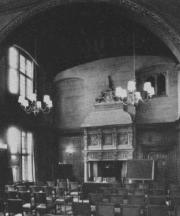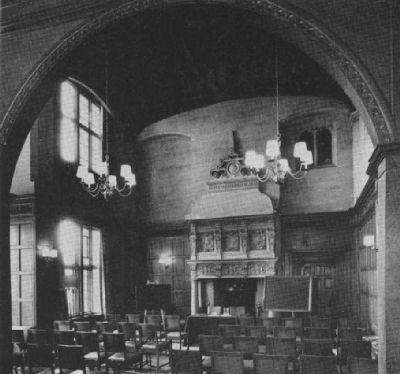
Following an IUPAC-supported
conference on polymer science at
Nottingham in 1958, the organisers were left with a small
financial surplus that belonged to no established Group. After
discussions they established The British High Polymer
Research Group to support polymer science, primarily in the UK,
through a series of annual conferences; "British" was later
dropped. The idea was to adopt a Gordon Conference-type format,
but with better accommodation, with the emphasis on discussion,
and specifically unreported discussion to enhance the free
exchange of ideas. Attendance was by personal invitation and
designed to produce a balance of academic and industrial
participants and to maximise a high level of discussion on the
conference theme. The format was for three working days with a
limited number of presentations in the mornings and early
evenings, leaving afternoons free for informal interactions. An
additional feature was that the conference should be located in a
relatively isolated venue, with no alternative attractions or
distractions. Thus the Founders (link) laid down a format
that has persisted to this day. Full participation in the meeting
was expected. After the first day at an early meeting a
conversation between Professor Bawn and I went,
B: "Aren't you interested in this meeting?";
Me: "Yes, I am. Why do you ask?";
B: "You haven't asked a question yet.",
— I soon did. In 1965 two
representatives came from Courtaulds Ltd, Coventry, with
instructions not to make comments or ask questions; they attended
once!
The founding chairman was Sir Harry Melville (University of Birmingham), who was involved with the Society of Chemical Industry (SCI), and the initial Secretary was Col. Francis Griffin, General Secretary of the SCI. It is thought the latter identified the initial conference location as The Manor House Hotel, Moretonhampstead within the Dartmoor National Park in Devon. This was a five-star railway hotel with its own golf course and trout fishing and, although ownership changed several times, remained the venue for 43 years. In the early days especially the hotel was expensive and senior industrialists were expected to have expense accounts to buy drinks for impecunious young academics. The only 'distraction' was the Ring of Bells, a 12th century pub in the neighbouring village of North Bovey, where many participants interacted after dinner most evenings.

Above: A photograph of the Cathedral Lounge at Moretonhampstead, the location of many of the early meetings of the High Polymer Research Group.
The initial meeting room was the two-story Cathedral Lounge with minstrel's gallery. The structure limited attendance to about 90 who could see the screen. The Group's first conference was also the hotel's first conference but it later attracted other meetings. Our conferences always started with participants arriving the last Monday in April. Later, as other hotel activities developed, arrival was, and (normally) remains, the last Sunday in April. As other conferences developed the hotel inserted a floor across the cathedral Lounge to create an unrestricted first-floor conference room for 100 participants. Because of the size of the hotel, both formats meant that most participants had to share bedrooms. Some senior participants avoided that by bringing wives. Speakers' only privilege was single rooms. In the early days, nobody, including foreign speakers, received any financial assistance with travel or accommodation. Nevertheless, the meetings always attracted distinguished speakers, including Nobel Prize winners, and few declined invitations to speak, such as the rapidly-established reputation of the meetings. P. J. Flory gave the opening lecture at the first meeting. The first to dent the principle over travel funds was Michael Szwarc, who also dented Alistair North's car, which he had borrowed, while driving in the narrow Devon lanes!
Thus the conference series continued for many years, with gradual changes to the Council. The Group, a registered charity, has maintained its initial principles. Sir Harry Melville retired as Chairman in 1981, to be replaced by, in turn, Professor John Bevington (Lancaster University), Professor Ian Cowie (University of Stirling and Heriot-Watt University), Professor Dame Julia Higgins (Imperial College), and now Professor Tony Ryan (University of Sheffield). After Francis Griffin retired as Secretary he was replaced by Julia Higgins, Isabel Miles and Roger Epton, for short periods, then Professor Aubrey Jenkins for about ten years, Geoff Eastmond for about six, then Professors Phil Hodge and John Stanford in tandem until 2011 when Phil Hodge retired as Secretary and Treasurer. The role was taken over by John Stanford with Randal Richards as assistant until 2013 when he became Secretary and Treasurer. Initially Ezat Khoshdel from Unilever was assistant until 2015 when Ken Lewtas assumed the position.
After a few years a conference tie was introduced; the colour combination varied from time to time. The initial design, of alternating rows of -C-C- backbones, in the all-trans conformation, and rampant Scottish lions (Sir Harry was a Scot), designed on a trans-Atlantic flight, was agreed by Council members on a Greyhound bus between Baton Rouge and New Orleans. Over the years the design remained similar, except once when the bond angle was strained to 120° (polyacetylene?). At one stage many lions died off to leave two, one at each end, but they recovered to form layers between every other layer of -C-C- chains. For many years provision of an equivalent for female participants remained a problem until 2004 when scarves, incorporating the same motif, were introduced. The ties are worn and recognised world-wide.
Formal education in polymer science was not traditionally part of the academic curriculum. Therefore, apart from providing a high level of discussion on current topics of research interest, the conferences have provided a source of continuing high-level education on new aspects of the subject for several participants.
Thus, the conferences, known generally as the "Moretonhampstead Conferences", continued for 42 years. Just months before the 43rd conference a bomb-shell landed. The hotel manager announced that although the planned 43rd conference could proceed, the hotel had been sold and would not be available in 2004. The hotel was going to be refurbished with fewer rooms, as suites, and re-construction of the Cathedral Lounge, reducing conference space and accommodation, with higher prices; it is now Bovey Castle.
There was a period of frenetic activity to find an alternative future venue and, fortunately, Shrigley Hall Hotel, at Pott Shrigley, near Macclesfield, was identified as a virtual clone of the Manor House Hotel. Shrigley Hall Hotel already had a swimming pool, as well as its own golf course and was situated on the edge of the Peak District National Park. Both hotels had been family residences; Shrigley Hall Hotel had also been a Salesian monastery and Roman Catholic boys' school and even has a monks' graveyard. The most significant loss on moving was that Shrigley Hall does not have an equivalent to The Ring of Bells. So, Dartmoor was exchanged for the Peak District. The 43rd meeting at the Manor House Hotel was an emotional event that ended with fireworks. Now the conferences are happily located at Shrigley Hall which has more rooms and can provide accommodation without sharing rooms in most instances, removing one of the major problems for incumbent secretaries.
by Geoff Eastmond, August 2007
Founding members
The Group was established by a small group of scientists, from universities and industry, who were prominent as founders and promoters of polymer science in the UK. The original committee was:
- Sir Harry Melville FRS KCB (Chairman)
- Dr C. H. Bamford (Courtaulds Ltd, later Professor Bamford FRS, University of Liverpool)
- Dr J. W. Barrett (Monsanto)
- Professor C. E. H. Bawn CBE, FRS (University of Liverpool)
- Dr J. C. Bevington (University of Birmingham, later Professor Bevington, University of Lancaster)
- Professor F. S. Dainton FRS (University of Leeds)
- Professor G. Gee FRS (University of Manchester)
- Mr E. A. Murphy (Dunlop Rubber Company)
- and Lt Col. F. J. Griffin (General Secretary, Society of Chemical Industry)











